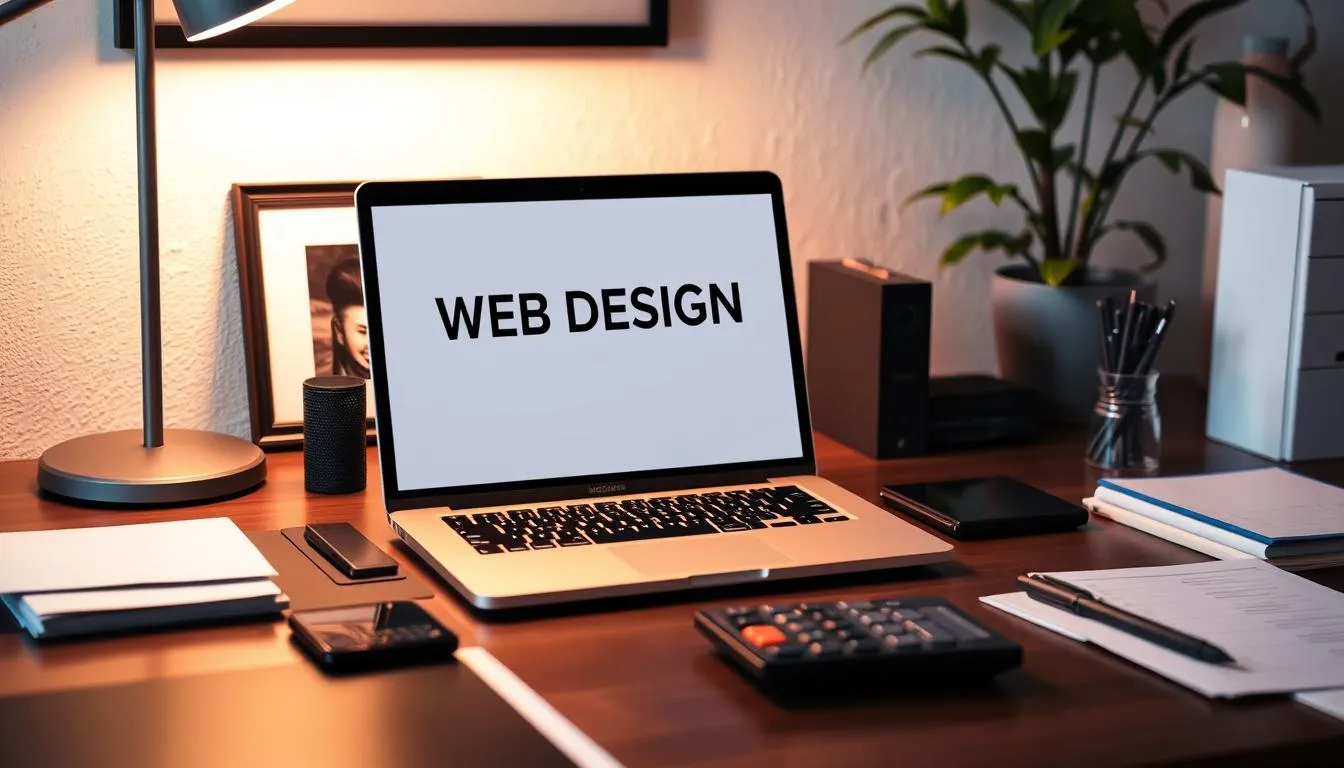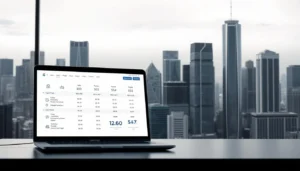Last Updated on: June 19, 2025
Creating a professional small business website is a crucial step in establishing an online presence. In today’s digital age, a well-designed website is essential for attracting and retaining customers. However, understanding the web design cost can be overwhelming, especially for small business owners without a technical background.
A well-designed website can help small businesses build credibility, increase brand awareness, and drive sales. But, the cost of creating such a website can vary greatly depending on several factors.
Key Takeaways
- Understanding the factors that influence web design costs is crucial for small businesses.
- A well-designed website is essential for establishing a strong online presence.
- The cost of web design can vary greatly depending on the complexity of the project.
- Small businesses should consider their budget and goals when planning their website.
- A professional website can help small businesses build credibility and drive sales.
Understanding Web Design Costs for Small Businesses
Understanding the intricacies of web design costs is crucial for small businesses looking to establish an online presence. The cost of creating a website can vary significantly based on several factors, including the size of the website, design complexity, and required functionalities.
Average Price Ranges in the US Market
The average cost of web design in the US market can range from a few hundred dollars to tens of thousands of dollars. For small businesses, typical website costs can fall between $1,000 and $10,000. Here’s a breakdown of average price ranges:
What You’re Actually Paying For
When you invest in web design, you’re paying for a combination of services that include design elements and technical development.
Design Elements
Design elements encompass the visual aspects of your website, including layout, color scheme, typography, and graphics. A well-designed website can enhance user experience and reflect your brand’s identity.
Technical Development
Technical development involves building the website’s functionality, including coding, content management systems (CMS), and responsive design. This ensures your website is not only visually appealing but also functional and accessible across various devices.
How Much Does Web Design for Small Businesses Cost?
Understanding the cost of web design is crucial for small businesses looking to establish an online presence. The cost can vary widely based on the complexity, features, and quality of the website.
Basic Website: $1,000-$5,000
A basic website is ideal for small businesses with limited budgets. It typically includes a simple design, a few pages (home, about, services, contact), and basic functionality. This tier is perfect for businesses that want to establish an online presence without advanced features.
Key Features: Simple design, limited pages, basic functionality.
Mid-Range Website: $5,000-$10,000
A mid-range website offers more advanced features and a more customized design. It’s suitable for businesses that need additional functionality such as contact forms, blog sections, or basic e-commerce integration.
Enhanced Features: Customized design, additional pages, advanced functionality like contact forms and blog sections.
Premium Website: $10,000+
Premium websites are designed for businesses that require advanced features, custom designs, and complex functionality. These websites often include e-commerce solutions, custom applications, and high-level SEO integration.
Advanced Features: Custom designs, complex functionality, e-commerce solutions, and advanced SEO.
Factors That Influence Web Design Pricing
The cost of web design for small businesses can vary significantly based on several key factors. Understanding these elements can help you make informed decisions when budgeting for your website.
Website Size and Complexity
The size and complexity of your website play a crucial role in determining its cost. A simple website with a few pages will be less expensive than a complex e-commerce site with multiple product categories and detailed product information. Generally, the more pages and features your site requires, the higher the design cost will be.
Design Customization Level
The level of design customization is another significant factor. A basic template design will be more affordable, while a custom design that reflects your brand’s unique identity and resonates with your target audience will cost more. A custom design requires more time and expertise, thus increasing the overall cost.
Functionality Requirements
The functionality you need for your website also impacts the pricing. Basic functionality like contact forms and social media integration is standard, but advanced features such as e-commerce capabilities, custom applications, or complex databases require more development time and expertise, thereby increasing the cost.
Designer Experience and Location
The experience and location of your web designer or agency can also influence the cost. More experienced professionals or those based in high-cost areas may charge higher rates. However, their expertise can result in a more effective and efficient website.
“Investing in a professional web design can pay off in the long run by providing a better user experience and improving your online presence.”
By understanding these factors, small businesses can better navigate the web design process and create a website that meets their needs and budget.
Breaking Down the Cost Components
Understanding the breakdown of web design costs is crucial for small businesses looking to establish an online presence. The total cost of web design can be broken down into several key components, each playing a vital role in the overall functionality and effectiveness of the website.
Domain Name and Hosting
The first step in creating a website is securing a domain name and hosting service. The cost of a domain name can range from $10 to $50 per year, depending on the registrar and the domain’s popularity. Hosting services can cost anywhere from $3 to $30 per month, depending on the type of hosting (shared, VPS, or dedicated) and the provider.
Design and Development
Design and development are the core components of web design, involving the creation of the visual layout, user interface, and functionality of the website. The cost of design and development can vary widely, depending on the complexity of the site and the experience of the designer or developer.
Content Creation
Content creation is a critical aspect of web design, encompassing copywriting, photography, and graphics. High-quality content can significantly enhance the user experience and engagement.
Copywriting
Copywriting involves crafting compelling text that resonates with the target audience. Professional copywriting services can cost between $50 to $500 per page, depending on the complexity and length of the content.
Photography and Graphics
Custom photography and graphics can add a unique touch to the website. The cost of photography can range from $200 to $2,000 per day, while graphics design can cost between $50 to $500 per item.
Responsive Design
Responsive design ensures that the website is accessible and visually appealing across various devices, including desktops, tablets, and smartphones. The cost of responsive design can vary, but it’s typically included in the overall design and development cost.
Additional Features and Their Costs
Additional features can significantly impact the overall cost of your small business website, offering enhanced capabilities and user experiences. When planning your website, it’s crucial to understand the costs associated with these features to make informed decisions.
E-commerce Functionality ($500-$5,000+)
Integrating e-commerce functionality into your website allows you to sell products or services directly online. The cost varies widely based on the complexity of the e-commerce platform, the number of products, and the payment gateways required. Basic e-commerce setups can start at around $500, while more complex systems with multiple integrations can cost $5,000 or more.
Content Management Systems ($0-$3,000)
A Content Management System (CMS) enables you to manage and update your website’s content easily. Popular CMS options like WordPress are free, but customizing and configuring a CMS to suit your needs can range from $0 to $3,000, depending on the level of customization and expertise required.
Custom Applications ($1,000-$10,000+)
Custom applications are tailored solutions designed to meet specific business needs, such as booking systems or inventory management. The cost of custom applications can vary significantly, from $1,000 for simple applications to $10,000 or more for complex systems requiring extensive development.
SEO Integration ($300-$2,000)
SEO integration involves optimizing your website to rank higher in search engine results. Costs for SEO integration can range from $300 for basic on-page optimizations to $2,000 or more for comprehensive SEO strategies that include content creation and link building.
One-Time vs. Ongoing Costs
Understanding the financial commitment required for web design involves distinguishing between one-time costs and ongoing expenses. When budgeting for a website, small businesses must consider both the initial investment and the continuous expenditures associated with maintaining and updating their online presence.
Initial Development Costs
The initial development cost is a one-time expense that covers the design and development of the website. This includes the cost of creating the visual design, writing the code, and setting up the necessary infrastructure. The price for this can vary widely, from $1,000 to $10,000 or more, depending on the complexity and features of the website.
Monthly and Annual Expenses
In addition to the initial development cost, small businesses should budget for monthly and annual expenses. These can include domain registration ($10-$30 per year), web hosting ($5-$50 per month), and any ongoing maintenance or update services. Some businesses may also choose to invest in regular content updates or SEO services to keep their website fresh and competitive.
Maintenance and Update Fees
Ongoing maintenance is crucial for ensuring the website remains secure, up-to-date, and continues to perform well. Maintenance fees can vary, with some providers charging a flat monthly rate (e.g., $50-$200) and others billing hourly for specific updates or services. Regular maintenance is essential for protecting against cyber threats and ensuring compatibility with the latest browsers and devices.
By understanding the distinction between one-time and ongoing costs, small businesses can better plan their budget for web design and ensure they have the necessary resources to maintain a strong online presence.
DIY vs. Professional Web Design: Cost Comparison
Small businesses often face a dilemma: should they use website builders for a DIY web design or hire professionals for a more customized solution? The decision hinges on several factors, including budget, required features, and the level of customization needed.
Website Builders: $0-$500
Website builders offer a cost-effective solution for small businesses looking to establish an online presence quickly. These platforms provide drag-and-drop tools and templates that make it easy to create a website without needing to know how to code.
Popular Platforms and Their Pricing
- Wix: Starts at $14/month
- Squarespace: Starts at $14/month
- Weebly: Starts at $12/month
Limitations to Consider
While website builders are affordable and user-friendly, they have limitations. These include:
- Limited customization options
- Dependence on the platform’s hosting and maintenance
- Limited scalability for complex websites
Freelancers: $500-$5,000
Freelancers offer a middle ground between DIY website builders and large agencies. They provide professional web design services at a lower cost than agencies, with the potential for more personalized service.
The cost of hiring a freelancer can vary widely based on their experience, the complexity of the project, and the technology used.
Agencies: $3,000-$15,000+
Web design agencies offer comprehensive services, including design, development, content creation, and ongoing maintenance. They have the resources and expertise to handle complex projects and provide a high level of professionalism.
While agencies are the most expensive option, they offer a high return on investment for businesses that need a sophisticated online presence.
How to Budget for Your Small Business Website
To effectively budget for a small business website, you need to understand the various cost components involved. This includes determining your website needs, evaluating quotes and proposals from designers, and creating a realistic timeline and budget.
Determining Your Website Needs
Before you start budgeting, it’s essential to determine what your website needs to achieve. Consider the purpose of your website, the features you require, and the level of customization needed. This will help you create a more accurate budget and ensure that you’re not overspending on unnecessary features.
Key considerations include the type of content management system (CMS) you’ll need, whether you’ll require e-commerce functionality, and if you need custom applications.
Evaluating Quotes and Proposals
When evaluating quotes and proposals from web designers, look beyond the price tag. Consider the scope of work, the timeline, and the level of support provided. Ensure that the proposal includes all the necessary components, such as design, development, content creation, and responsive design.
Be wary of extremely low quotes, as they may indicate a lack of experience or a hidden costs down the line.
Creating a Realistic Timeline and Budget
Creating a realistic timeline and budget is crucial to the success of your website project. Break down the project into smaller tasks, estimate the time required for each task, and allocate resources accordingly.
Consider using a project management tool to help you stay on track and ensure that all stakeholders are informed.
Conclusion
Understanding the intricacies of web design cost is crucial for small businesses aiming to establish a strong online presence. As discussed, the cost of web design for small businesses varies widely based on factors such as website size, design customization, and required functionalities.
By breaking down the cost components, including domain name, hosting, design, development, and content creation, businesses can better navigate the process. Additionally, considering one-time vs. ongoing costs and evaluating quotes from freelancers or agencies can help in creating a realistic budget.
Ultimately, investing in a well-designed website can significantly enhance a small business’s visibility and customer engagement. By being informed about web design costs and carefully planning the project, businesses can achieve their online goals without exceeding their budget.
FAQ
What is the average cost of web design for small businesses in the US?
The average cost can range from $1,000 to $15,000 or more, depending on the complexity and features of the website.
What factors influence the cost of web design for small businesses?
Factors such as website size, design customization, functionality requirements, and the experience and location of the designer can significantly impact the cost.
How much does a basic website cost?
A basic website can cost between $1,000 and $5,000, typically including a simple design, a few pages, and standard features.
What is the cost of e-commerce functionality for a website?
E-commerce functionality can range from $500 to $5,000 or more, depending on the complexity of the online store and the number of products.
Do I need to pay for ongoing maintenance and updates?
Yes, ongoing maintenance and updates are necessary to keep your website secure and up-to-date, with costs ranging from $50 to $500 per month.
Can I use a website builder like Wix or Squarespace instead of hiring a professional?
Website builders like Wix and Squarespace can be a cost-effective option, with prices starting at $0 to $500, but may have limitations in terms of customization and features.
How much does SEO integration cost?
SEO integration can cost between $300 and $2,000, depending on the scope of the work and the experience of the SEO specialist.
What is the difference between a freelancer and an agency for web design?
Freelancers typically charge lower rates, between $500 and $5,000, while agencies can charge higher rates, $3,000 to $15,000 or more, depending on the scope and complexity of the project.
How do I determine my website needs and budget?
To determine your website needs and budget, consider your business goals, target audience, and required features, and evaluate quotes and proposals from designers to create a realistic timeline and budget.




